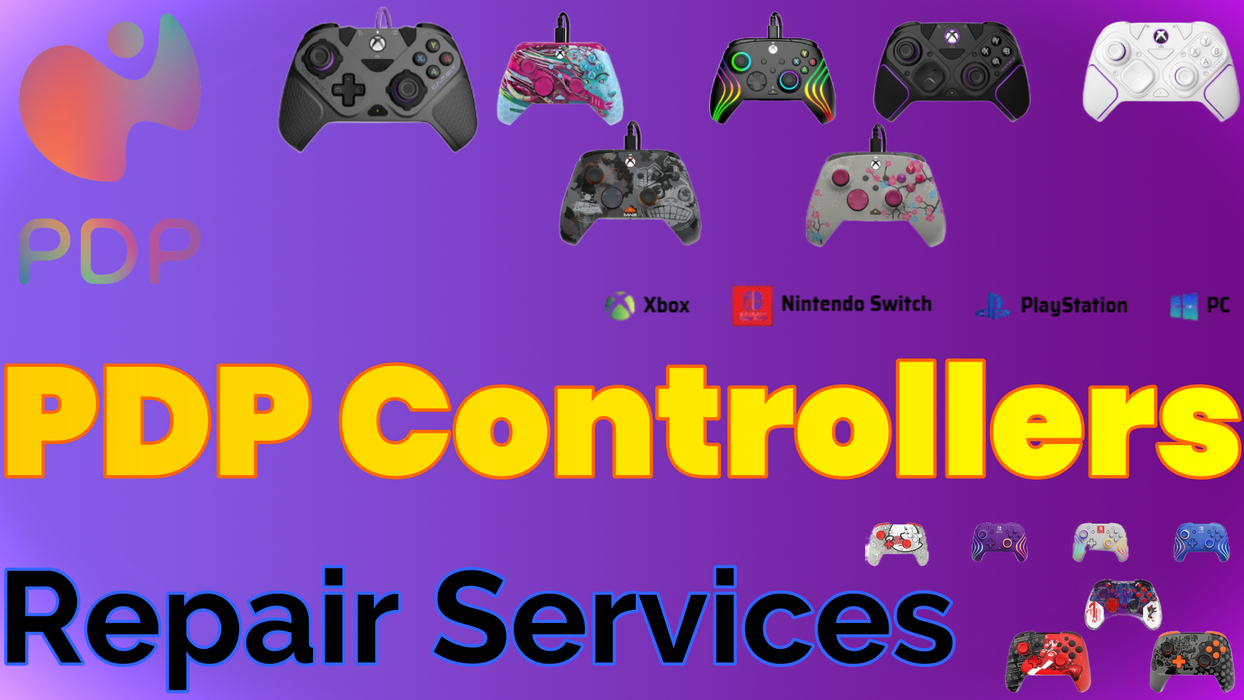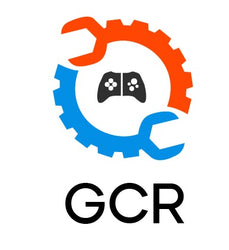

PDP Gaming Controller Repairs
Get a FREE Quote
PDP (Performance Designed Products) gaming controllers are popular due to their affordability and wide compatibility with various gaming consoles. However, like any gaming peripherals, PDP controllers can encounter issues over time. Here are the common problems associated with PDP gaming controllers and their repair solutions:
1. Analog Stick Drift
- Problem: The analog sticks register movement even when they are not being touched, causing characters to move on their own in games.
- Cause: Worn-out or dirty potentiometers inside the analog stick assembly.
- Solution: Clean the analog stick with compressed air or contact cleaner. If this doesn't work, replacing the analog stick module is often necessary.
2. Unresponsive Buttons
- Problem: Some buttons do not respond or need to be pressed harder than usual to work.
- Cause: Dust, debris, or worn-out contact pads under the buttons.
- Solution: Open the controller and clean the contact pads under the buttons. If cleaning doesn’t solve the issue, the contact pads or the rubber membrane may need to be replaced.
3. Broken Trigger Buttons (L2/R2)
- Problem: The trigger buttons (L2/R2) get stuck or don’t register input.
- Cause: Broken trigger mechanisms, dirt buildup, or faulty springs.
- Solution: Open the controller to inspect the trigger mechanism and clean it. Replace the spring or trigger components if they are broken.
4. D-Pad Issues
- Problem: The D-pad is either too sensitive, registering unintended inputs, or unresponsive.
- Cause: Misalignment or dirt under the D-pad, or worn contacts.
- Solution: Clean the D-pad and realign it. If the issue persists, replace the D-pad mechanism.
5. Loose or Worn Thumbsticks
- Problem: The thumbsticks feel loose or wobbly, or have lost precision during gameplay.
- Cause: Wear and tear on the thumbstick mechanism.
- Solution: Replace the thumbstick module if it feels too loose or worn.
6. Wireless Connectivity Problems (For Wireless Models)
- Problem: The controller disconnects randomly or fails to connect to the console or PC.
- Cause: Interference, low battery, or outdated firmware.
- Solution: Re-pair the controller with the console, update the firmware if possible, or replace the battery if it’s not holding a charge.
7. Charging or Battery Issues (For Wireless Models)
- Problem: The controller won’t charge, or the battery drains too quickly.
- Cause: A faulty battery, damaged charging cable, or charging port issues.
- Solution: Test with a different charging cable and port. If the battery is defective, replace it.
8. Vibration Motors Not Working
- Problem: The vibration or rumble feature isn’t working or is inconsistent.
- Cause: Faulty or disconnected vibration motors.
- Solution: Open the controller to check the connections to the vibration motors. If they are disconnected, reconnect them. If the motors are damaged, they will need to be replaced.
9. Headphone Jack Issues
- Problem: The 3.5mm headphone jack either doesn’t transmit audio or produces static.
- Cause: Dirt or damage to the headphone jack.
- Solution: Clean the headphone jack using compressed air or replace it if it’s damaged.
10. Sticky Buttons
- Problem: Buttons stay pressed down or don’t spring back immediately.
- Cause: Dust, dirt, or sticky residue under the buttons.
- Solution: Clean the buttons and their surrounding area. If the problem continues, the rubber membrane may need replacement.
11. Firmware/Software Compatibility Issues
- Problem: After a console or game update, the controller stops functioning or experiences input lag.
- Cause: Incompatibility between the controller’s firmware and the new system update.
- Solution: Update the controller’s firmware (if supported) or reconfigure it on the console/PC settings.
12. Broken or Damaged Cables (For Wired Models)
- Problem: The wired controller disconnects or stops working when the cable is moved.
- Cause: A damaged or frayed cable near the USB connector.
- Solution: Replace the USB cable if it is detachable, or repair the internal wiring if the cable is permanently attached.
13. Calibration Problems
- Problem: The controller’s inputs seem inaccurate or out of sync during gameplay.
- Cause: Miscalibration of the thumbsticks or triggers.
- Solution: Recalibrate the controller using the console or PC settings to resolve input precision issues.
14. Overheating
- Problem: The controller becomes hot during extended gaming sessions.
- Cause: Prolonged use without adequate ventilation or internal electrical faults.
- Solution: Take breaks during long gaming sessions. If overheating persists, inspect the controller for electrical issues.
15. Loose Housing
- Problem: The outer casing feels loose or rattles during use.
- Cause: Internal screws have become loose, or the plastic casing is damaged.
- Solution: Open the controller and tighten the screws holding the casing. If the plastic casing is damaged, it may need to be replaced.
16. Non-Functional Shoulder Buttons (L1/R1)
- Problem: The shoulder buttons stop responding or require more pressure to register.
- Cause: Worn-out or damaged button mechanisms.
- Solution: Open the controller to inspect the shoulder buttons and replace any damaged parts.
17. Cosmetic Wear
- Problem: The controller's exterior shows significant wear, such as peeling grips or fading.
- Cause: Prolonged use or exposure to harsh conditions.
- Solution: Replace any worn-out grips or consider applying a controller skin for protection.
18. Loose or Faulty USB Ports
- Problem: The controller's USB connection is unstable, causing disconnection during use.
- Cause: Damaged or loose USB port or connectors.
- Solution: Inspect the USB port for damage and either re-solder the connections or replace the port if necessary.
19. Latency/Input Lag
- Problem: Delayed response between pressing buttons and the corresponding in-game action.
- Cause: Wireless interference, outdated drivers, or low battery.
- Solution: Use a wired connection if possible, ensure the controller is charged, or update the drivers/firmware.
20. Failure to Power On
- Problem: The controller doesn’t turn on, even when connected or charged.
- Cause: A faulty power button, dead battery, or internal circuit issue.
- Solution: Check the battery and power button for issues. If neither is faulty, the controller’s internal board may need repair or replacement.
Conclusion:
PDP gaming controllers can experience a variety of issues over time, from stick drift and button unresponsiveness to connection problems and cosmetic wear. Many of these problems can be resolved with cleaning, recalibration, or part replacement. For more severe issues, such as internal wiring problems or power failures, professional repairs may be required.
Product Reviews
Add customer reviews and testimonials to showcase your store's happy customers.
Author's name
Add customer reviews and testimonials to showcase your store's happy customers.
Author's name
Add customer reviews and testimonials to showcase your store's happy customers.
Author's name
